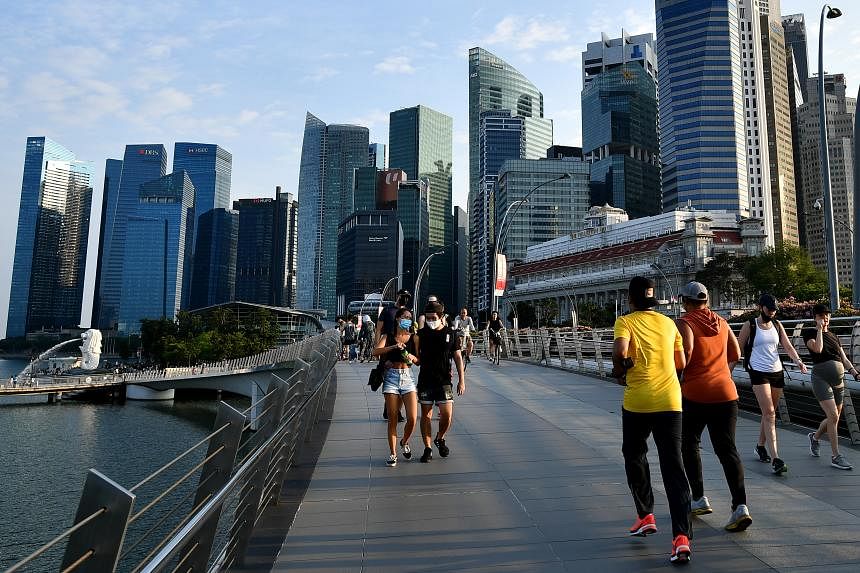SINGAPORE – Private sector economists expect the Singapore economy to weaken further in the third quarter, compared with a prediction in June, but the pooled forecast of 1 per cent appears somewhat optimistic when cast against the actual 0.5 per cent gross domestic product expansion posted in the second quarter.
The forecasters’ latest expectation of year-on-year GDP growth is lower than the anticipated 1.4 per cent in the June edition, according to the quarterly survey by the Monetary Authority of Singapore (MAS) released on Wednesday.
In a breakdown of key indicators, non-oil domestic exports (Nodx) posted the sharpest anticipated decline and are expected to fall by 10.5 per cent in the current forecast, down from minus 5.5 per cent in the June survey.
This is also reflected in the data for the manufacturing sector, which accounts for more than a fifth of the Singapore economy, as it is forecast to post a 4.4 per cent year-on-year decline, from minus 1.3 per cent in June and no growth in March.
OCBC Bank chief economist Selena Ling said the downgrade of full-year 2023 growth expectations is partly due to the disappointing revision to the second-quarter GDP data, as well as growing concerns about China’s slowdown post-reopening.
“For the manufacturing sector, it is facing a soft patch in external demand, especially for electronics – the semiconductor industry in particular,” she said.
Other economists believe that the September survey may be cause for some measure of optimism.
Maybank Research senior economist Chua Hak Bin said “the worst of the manufacturing downturn may be behind us and there are signs of a recovery early in the third quarter”.
“If the trade- and hospitality-related service sectors hold up, third-quarter GDP growth might come in slightly above 1 per cent,” he said.
“The contraction in Nodx was not mirrored in the trade-related service sectors and could suggest that regional trade and shipping activity may be picking up,” Dr Chua added.
DBS Bank economist Chua Han Teng also expects a rebound in the third quarter, “which is in line with our expectations for a gradual and fragile recovery in the second half of this year”.
He expects this growth to be supported by the tourism-linked sectors, which are the fastest-growing segments and are likely to benefit from the ongoing recovery in international tourism and large-scale events such as September’s Singapore Grand Prix.
Meanwhile, the September survey expects finance and insurance to post a much smaller growth of 0.7 per cent year on year, from 1.3 per cent in the June forecast.
Commenting on the data, Ms Ling said the downgrade in bank loans growth was due to the twin challenges of an elevated interest rate environment and tepid loan demand, especially for domestic business loans.
“Business sentiment had likely taken a hit after the recent negative news headlines pertaining to the Chinese economy and a more hawkish United States Federal Reserve,” she noted, saying that major central banks, such as the US Federal Reserve and the European Central Bank, are signalling that “they are not done with tightening just yet”.
On the domestic front, while wholesale and retail trade edged higher to 1.3 per cent year on year, from 0.8 per cent, accommodation and food services noticeably softened to 8.8 per cent, after peaking at 10 per cent in the second quarter.
Dr Chua said the cooling off in accommodation and food services growth is largely expected “as the boost from the economic reopening and revenge travel fades”.
Private consumption remained fairly stable, dipping to 3.3 per cent year on year, from 3.5 per cent in the June forecast.
Inflation is forecast to ease, with the consumer price index posting a 4.7 per cent year-on-year change, from 5 per cent in the prior period, although core inflation stood unchanged at 4.1 per cent.
Meanwhile, the forecast overall unemployment rate nudged lower, to 2 per cent from 2.1 per cent, whereas bank loans are expected to fall into negative territory to minus 2.6 per cent, down from a 0.5 per cent expansion in the previous survey.
Focusing on the inflation and unemployment forecasts, Ms Ling said both sets of data bear watching.
On the one hand, the tight labour market would result in higher wage growth and may constrain businesses’ ability to pass on these costs to end-consumers, while on the other, rising energy and food prices may make inflation more volatile, and hence, more challenging for central banks in the coming months.
Among corporate and financial indicators, the forecast for corporate profitability appeared less pessimistic, with two-thirds of the respondents expecting lower earnings, down from 77.8 per cent in the earlier forecast.
The remainder were evenly split between better or unchanged profitability, as was the case in the June survey.
A total of 22 economists and analysts who monitor the local economy responded to the MAS survey sent out on Aug 15.
For 2024, the economic forecast remained unchanged at 2.5 per cent year on year in both the June and September surveys.
Ms Ling said the 2024 growth prognosis is still for a rebound, especially given the potentially lower base of comparison with 2023.
S'pore cuts 2023 economic growth forecast to 0.5-1.5% on weak export outlook
Inflation is falling – so now what?
Join ST’s Telegram channel and get the latest breaking news delivered to you.
p.st_telegram_boilerplate:before {
display: inline-block;
content: ” “;
border-radius: 6px;
height: 6px;
width: 6px;
background-color: #12239a;
margin-left: 0px;
margin-right: 13px;
}
a.st_boilerplate {
font-family: “SelaneWebSTForty”, Georgia, “Times New Roman”, Times, serif;
}


